- GCN/BACODINE POSITION NOTICE
TITLE: GCN/SWIFT NOTICE
NOTICE_DATE: Tue 16 Mar 10 12:46:09 UT
NOTICE_TYPE: Swift-BAT GRB Position
TRIGGER_NUM: 416135, Seg_Num: 0
GRB_RA: 107.615d {+07h 10m 28s} (J2000),
107.665d {+07h 10m 40s} (current),
107.372d {+07h 09m 29s} (1950)
GRB_DEC: -56.278d {-56d 16' 40"} (J2000),
-56.295d {-56d 17' 42"} (current),
-56.194d {-56d 11' 39"} (1950)
GRB_ERROR: 3.00 [arcmin radius, statistical only]
GRB_INTEN: 0 [cnts] Image_Peak=1835 [image_cnts]
TRIGGER_DUR: 64.000 [sec]
TRIGGER_INDEX: 20000 E_range: 15-50 keV
BKG_INTEN: 0 [cnts]
BKG_TIME: 0.00 SOD {00:00:00.00} UT
BKG_DUR: 0 [sec]
GRB_DATE: 15271 TJD; 75 DOY; 10/03/16
GRB_TIME: 45890.38 SOD {12:44:50.38} UT
GRB_PHI: -24.10 [deg]
GRB_THETA: 28.40 [deg]
SOLN_STATUS: 0x13
RATE_SIGNIF: 0.00 [sigma]
IMAGE_SIGNIF: 7.83 [sigma]
MERIT_PARAMS: +1 +0 +0 +6 +1 -2 +0 +0 +17 +0
SUN_POSTN: 356.16d {+23h 44m 39s} -1.66d {-01d 39' 38"}
SUN_DIST: 100.32 [deg] Sun_angle= -7.4 [hr] (East of Sun)
MOON_POSTN: 1.03d {+00h 04m 07s} +5.71d {+05d 42' 46"}
MOON_DIST: 103.94 [deg]
MOON_ILLUM: 0 [%]
GAL_COORDS: 266.92,-19.77 [deg] galactic lon,lat of the burst (or transient)
ECL_COORDS: 137.38,-76.80 [deg] ecliptic lon,lat of the burst (or transient)
COMMENTS: SWIFT-BAT GRB Coordinates.
COMMENTS: This is an image trigger. (The RATE_SIGNIF & BKG_{INTEN, TIME, DUR} are undefined.)
COMMENTS: A point_source was found.
COMMENTS: This does not match any source in the on-board catalog.
COMMENTS: This does not match any source in the ground catalog.
COMMENTS: This is a GRB.
COMMENTS: This trigger occurred at longitude,latitude = 121.70,-0.82 [deg].
- red DSS finding chart
ps-file
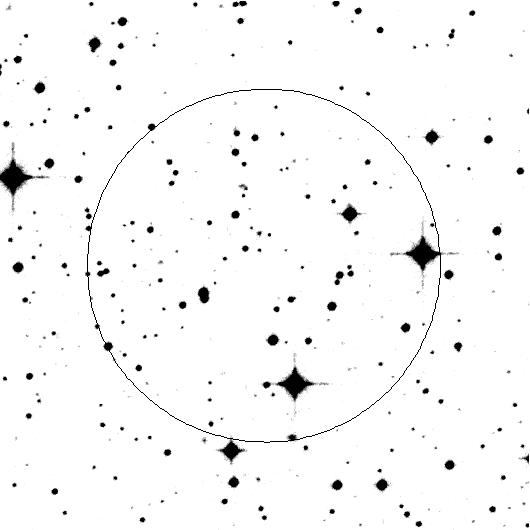
- GCN NOTICE
TITLE: GCN/SWIFT NOTICE
NOTICE_DATE: Tue 16 Mar 10 12:47:39 UT
NOTICE_TYPE: Swift-XRT Position
TRIGGER_NUM: 416135, Seg_Num: 0
GRB_RA: 107.6291d {+07h 10m 30.98s} (J2000),
107.6788d {+07h 10m 42.90s} (current),
107.3854d {+07h 09m 32.49s} (1950)
GRB_DEC: -56.2567d {-56d 15' 24.1"} (J2000),
-56.2739d {-56d 16' 26.1"} (current),
-56.1729d {-56d 10' 22.6"} (1950)
GRB_ERROR: 5.0 [arcsec radius, statistical plus systematic, 90% containment]
GRB_INTEN: 2.38e-09 [erg/cm2/sec]
GRB_SIGNIF: 8.83 [sigma]
IMG_START_DATE: 15271 TJD; 75 DOY; 10/03/16
IMG_START_TIME: 46028.07 SOD {12:47:08.07} UT, 137.7 [sec] since BAT Trigger Time
TAM[0-3]: 327.65 237.26 261.52 243.37
AMPLIFIER: 2
WAVEFORM: 134
SUN_POSTN: 356.17d {+23h 44m 40s} -1.66d {-01d 39' 36"}
SUN_DIST: 100.34 [deg] Sun_angle= -7.4 [hr] (East of Sun)
MOON_POSTN: 1.04d {+00h 04m 10s} +5.72d {+05d 43' 06"}
MOON_DIST: 103.95 [deg]
MOON_ILLUM: 0 [%]
GAL_COORDS: 266.90,-19.76 [deg] galactic lon,lat of the burst
ECL_COORDS: 137.35,-76.78 [deg] ecliptic lon,lat of the burst
COMMENTS: SWIFT-XRT Coordinates.
COMMENTS: The XRT position is 1.35 arcmin from the BAT position.
- GCN NOTICE
TITLE: GCN/SWIFT NOTICE
NOTICE_DATE: Tue 16 Mar 10 12:47:49 UT
NOTICE_TYPE: Swift-XRT Image
TRIGGER_NUM: 416135, Seg_Num: 0
GRB_RA: 107.6291d {+07h 10m 30.9s} (J2000),
107.6788d {+07h 10m 42.9s} (current),
107.3854d {+07h 09m 32.4s} (1950)
GRB_DEC: -56.2567d {-56d 15' 24.1"} (J2000),
-56.2739d {-56d 16' 26.1"} (current),
-56.1729d {-56d 10' 22.6"} (1950)
GRB_ERROR: 5.0 [arcsec, radius, statistical plus systematic]
GRB_INTEN: 78 [cnts]
IMG_START_DATE: 15271 TJD; 75 DOY; 10/03/16
IMG_START_TIME: 46028.07 SOD {12:47:08.07} UT, 137.7 [sec] since BAT Trigger Time
CENTROID_X: 299.96, raw= 300 [pixels]
CENTROID_Y: 275.09, raw= 275 [pixels]
ROLL: 250.99 [deg]
GAIN: 1
MODE: 3, Long Image mode
WAVEFORM: 134
EXPO_TIME: 2.50 [sec]
GRB_POS_XRT_Y: -53.99
GRB_POS_XRT_Z: -5.51
IMAGE_URL: sw00416135000msxps_rw.img
SUN_POSTN: 356.17d {+23h 44m 40s} -1.66d {-01d 39' 36"}
SUN_DIST: 100.34 [deg] Sun_angle= -7.4 [hr] (East of Sun)
MOON_POSTN: 1.04d {+00h 04m 10s} +5.72d {+05d 43' 08"}
MOON_DIST: 103.95 [deg]
MOON_ILLUM: 0 [%]
GAL_COORDS: 266.90,-19.76 [deg] galactic lon,lat of the burst
ECL_COORDS: 137.35,-76.78 [deg] ecliptic lon,lat of the burst
COMMENTS: SWIFT-XRT Image.

- GCN NOTICE
TITLE: GCN/SWIFT NOTICE
NOTICE_DATE: Tue 16 Mar 10 12:47:54 UT
NOTICE_TYPE: Swift-XRT Processed Image
TRIGGER_NUM: 416135, Seg_Num: 0
GRB_RA: 107.6291d {+07h 10m 30.9s} (J2000),
107.6788d {+07h 10m 42.9s} (current),
107.3854d {+07h 09m 32.4s} (1950)
GRB_DEC: -56.2567d {-56d 15' 24.1"} (J2000),
-56.2739d {-56d 16' 26.1"} (current),
-56.1729d {-56d 10' 22.6"} (1950)
GRB_ERROR: 5.0 [arcsec, radius, statistical plus systematic]
GRB_INTEN: 78 [cnts]
IMG_START_DATE: 15271 TJD; 75 DOY; 10/03/16
IMG_START_TIME: 46028.07 SOD {12:47:08.07} UT, 137.7 [sec] since BAT Trigger Time
CENTROID_X: 299.96, raw= 300 [pixels]
CENTROID_Y: 275.09, raw= 275 [pixels]
ROLL: 250.99 [deg]
GAIN: 1
MODE: 3, Long Image mode
WAVEFORM: 134
EXPO_TIME: 2.50 [sec]
GRB_POS_XRT_Y: -53.99
GRB_POS_XRT_Z: -5.51
IMAGE_URL: sw00416135000msxps_rw.img
SUN_POSTN: 356.17d {+23h 44m 40s} -1.66d {-01d 39' 36"}
SUN_DIST: 100.34 [deg] Sun_angle= -7.4 [hr] (East of Sun)
MOON_POSTN: 1.04d {+00h 04m 10s} +5.72d {+05d 43' 09"}
MOON_DIST: 103.95 [deg]
MOON_ILLUM: 0 [%]
GAL_COORDS: 266.90,-19.76 [deg] galactic lon,lat of the burst
ECL_COORDS: 137.35,-76.78 [deg] ecliptic lon,lat of the burst
COMMENTS: SWIFT-XRT Processed Image.

- GCN NOTICE
TITLE: GCN/SWIFT NOTICE
NOTICE_DATE: Tue 16 Mar 10 12:48:50 UT
NOTICE_TYPE: Swift-BAT GRB Lightcurve
TRIGGER_NUM: 416135, Seg_Num: 0
GRB_RA: 107.615d {+07h 10m 28s} (J2000),
107.665d {+07h 10m 40s} (current),
107.372d {+07h 09m 29s} (1950)
GRB_DEC: -56.278d {-56d 16' 40"} (J2000),
-56.295d {-56d 17' 42"} (current),
-56.194d {-56d 11' 39"} (1950)
GRB_DATE: 15271 TJD; 75 DOY; 10/03/16
GRB_TIME: 45890.38 SOD {12:44:50.38} UT
TRIGGER_INDEX: 20000
GRB_PHI: -24.10 [deg]
GRB_THETA: 28.40 [deg]
DELTA_TIME: 0.00 [sec]
TRIGGER_DUR: 64.000 [sec]
SOLN_STATUS: 0x13
RATE_SIGNIF: 0.00 [sigma]
IMAGE_SIGNIF: 7.83 [sigma]
LC_URL: sw00416135000msb.lc
SUN_POSTN: 356.17d {+23h 44m 40s} -1.66d {-01d 39' 35"}
SUN_DIST: 100.32 [deg] Sun_angle= -7.4 [hr] (East of Sun)
MOON_POSTN: 1.05d {+00h 04m 12s} +5.72d {+05d 43' 21"}
MOON_DIST: 103.94 [deg]
MOON_ILLUM: 0 [%]
GAL_COORDS: 266.92,-19.77 [deg] galactic lon,lat of the burst (or transient)
ECL_COORDS: 137.38,-76.80 [deg] ecliptic lon,lat of the burst (or transient)
COMMENTS: SWIFT-BAT GRB Lightcurve.
COMMENTS:
COMMENTS: The next comments were copied from the BAT_POS Notice:
COMMENTS: This is an image trigger.
COMMENTS: A point_source was found.
COMMENTS: This does not match any source in the on-board catalog.
COMMENTS: This does not match any source in the ground catalog.
COMMENTS: This is a GRB.
COMMENTS: This trigger occurred at longitude,latitude = 121.70,-0.82 [deg].
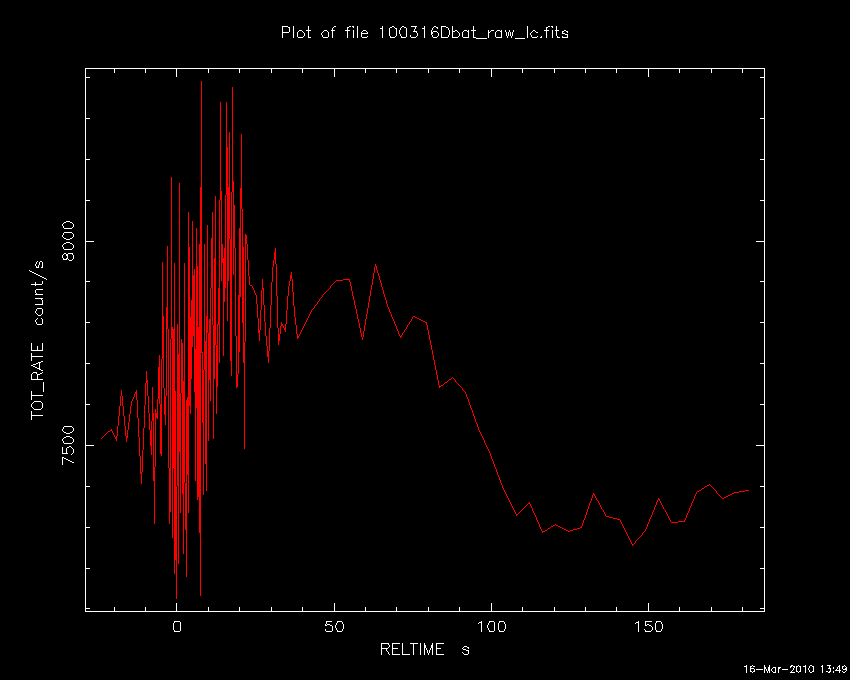
- GCN NOTICE
TITLE: GCN/SWIFT NOTICE
NOTICE_DATE: Tue 16 Mar 10 12:50:11 UT
NOTICE_TYPE: Swift-UVOT Source List
TRIGGER_NUM: 416135, Seg_Num: 0
POINT_RA: 107.641d {+07h 10m 34s} (J2000)
POINT_DEC: -56.270d {-56d 16' 10"} (J2000)
POINT_ROLL: 250.991d
IMG_START_DATE: 15271 TJD; 75 DOY; 10/03/16
IMG_START_TIME: 46038.60 SOD {12:47:18.60} UT, 148.2 [sec] since BAT Trigger Time
FILTER: 10, White
BKG_MEAN: 1.946
N_STARS: 190
X_OFFSET: 549 [pixels]
Y_OFFSET: 652 [pixels]
X_MAX: 1508 [pixels]
Y_MAX: 1611 [pixels]
DET_THRESH: 12
PHOTO_THRESH: 6
SL_URL: sw00416135000msufc0148.fits
SUN_POSTN: 356.17d {+23h 44m 40s} -1.66d {-01d 39' 34"}
SUN_DIST: 100.34 [deg] Sun_angle= -7.4 [hr] (East of Sun)
MOON_POSTN: 1.06d {+00h 04m 14s} +5.73d {+05d 43' 38"}
MOON_DIST: 103.95 [deg]
MOON_ILLUM: 0 [%]
GAL_COORDS: 266.92,-19.76 [deg] galactic lon,lat of the pointing direction
ECL_COORDS: 137.41,-76.79 [deg] ecliptic lon,lat of the pointing direction
COMMENTS: SWIFT-UVOT Source List.
- GCN NOTICE
TITLE: GCN/SWIFT NOTICE
NOTICE_DATE: Tue 16 Mar 10 12:50:40 UT
NOTICE_TYPE: Swift-UVOT Processed Source List
TRIGGER_NUM: 416135, Seg_Num: 0
POINT_RA: 107.641d {+07h 10m 34s} (J2000)
POINT_DEC: -56.270d {-56d 16' 10"} (J2000)
POINT_ROLL: 250.991d
IMG_START_DATE: 15271 TJD; 75 DOY; 10/03/16
IMG_START_TIME: 46038.60 SOD {12:47:18.60} UT, 148.2 [sec] since BAT Trigger Time
FILTER: 10, White
BKG_MEAN: 1.946
N_STARS: 190
X_OFFSET: 549 [pixels]
Y_OFFSET: 652 [pixels]
X_MAX: 1508 [pixels]
Y_MAX: 1611 [pixels]
DET_THRESH: 12
PHOTO_THRESH: 6
SL_URL: sw00416135000msufc0148.fits
SUN_POSTN: 356.17d {+23h 44m 40s} -1.66d {-01d 39' 33"}
SUN_DIST: 100.34 [deg] Sun_angle= -7.4 [hr] (East of Sun)
MOON_POSTN: 1.06d {+00h 04m 15s} +5.73d {+05d 43' 45"}
MOON_DIST: 103.95 [deg]
MOON_ILLUM: 0 [%]
GAL_COORDS: 266.92,-19.76 [deg] galactic lon,lat of the pointing direction
ECL_COORDS: 137.41,-76.79 [deg] ecliptic lon,lat of the pointing direction
COMMENTS: SWIFT-UVOT Processed Source List.
COMMENTS: All 4 attachments are included.
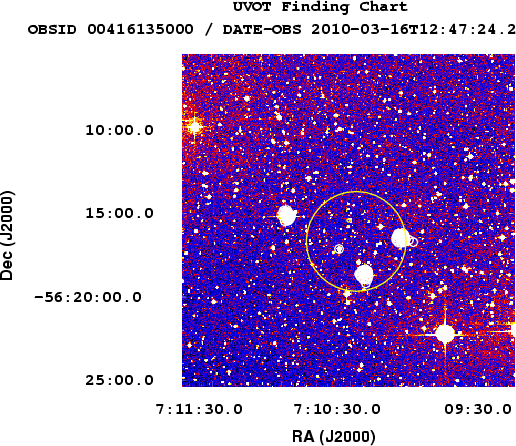
- GCN NOTICE
TITLE: GCN/SWIFT NOTICE
NOTICE_DATE: Tue 16 Mar 10 12:50:11 UT
NOTICE_TYPE: Swift-UVOT Source List
TRIGGER_NUM: 416135, Seg_Num: 0
POINT_RA: 107.641d {+07h 10m 34s} (J2000)
POINT_DEC: -56.270d {-56d 16' 10"} (J2000)
POINT_ROLL: 250.991d
IMG_START_DATE: 15271 TJD; 75 DOY; 10/03/16
IMG_START_TIME: 46038.60 SOD {12:47:18.60} UT, 148.2 [sec] since BAT Trigger Time
FILTER: 10, White
BKG_MEAN: 1.946
N_STARS: 190
X_OFFSET: 549 [pixels]
Y_OFFSET: 652 [pixels]
X_MAX: 1508 [pixels]
Y_MAX: 1611 [pixels]
DET_THRESH: 12
PHOTO_THRESH: 6
SL_URL: sw00416135000msufc0148.fits
SUN_POSTN: 356.17d {+23h 44m 40s} -1.66d {-01d 39' 34"}
SUN_DIST: 100.34 [deg] Sun_angle= -7.4 [hr] (East of Sun)
MOON_POSTN: 1.06d {+00h 04m 14s} +5.73d {+05d 43' 38"}
MOON_DIST: 103.95 [deg]
MOON_ILLUM: 0 [%]
GAL_COORDS: 266.92,-19.76 [deg] galactic lon,lat of the pointing direction
ECL_COORDS: 137.41,-76.79 [deg] ecliptic lon,lat of the pointing direction
COMMENTS: SWIFT-UVOT Source List.
- GCN NOTICE
TITLE: GCN/SWIFT NOTICE
NOTICE_DATE: Tue 16 Mar 10 12:51:56 UT
NOTICE_TYPE: Swift-UVOT Image
TRIGGER_NUM: 416135, Seg_Num: 0
POINT_RA: 107.641d {+07h 10m 34s} (J2000)
POINT_DEC: -56.270d {-56d 16' 10"} (J2000)
ROLL: 250.991d
IMG_START_DATE: 15271 TJD; 75 DOY; 10/03/16
IMG_START_TIME: 46038.60 SOD {12:47:18.60} UT, 148.2 [sec] since BAT Trigger Time
FILTER: 10, White
EXPOSURE_ID: 290436444
X_OFFSET: 869 [pixels]
Y_OFFSET: 972 [pixels]
WIDTH: 160 [pixels]
HEIGHT: 160 [pixels]
X_GRB_POS: 1029
Y_GRB_POS: 1132
BINNING_INDEX: 1
IM_URL: sw00416135000msuni0154.fits
SUN_POSTN: 356.17d {+23h 44m 40s} -1.66d {-01d 39' 32"}
SUN_DIST: 100.34 [deg] Sun_angle= -7.4 [hr] (East of Sun)
MOON_POSTN: 1.07d {+00h 04m 17s} +5.73d {+05d 44' 01"}
MOON_DIST: 103.95 [deg]
MOON_ILLUM: 0 [%]
GAL_COORDS: 266.92,-19.76 [deg] galactic lon,lat of the pointing direction
ECL_COORDS: 137.41,-76.79 [deg] ecliptic lon,lat of the pointing direction
COMMENTS: SWIFT-UVOT Image.
COMMENTS: The GRB Position came from the XRT Position Command.
COMMENTS: The image has 2x2 binning (compression).

- GCN NOTICE
TITLE: GCN/SWIFT NOTICE
NOTICE_DATE: Tue 16 Mar 10 12:52:15 UT
NOTICE_TYPE: Swift-UVOT Processed Image
TRIGGER_NUM: 416135, Seg_Num: 0
POINT_RA: 107.641d {+07h 10m 34s} (J2000)
POINT_DEC: -56.270d {-56d 16' 10"} (J2000)
ROLL: 250.991d
IMG_START_DATE: 15271 TJD; 75 DOY; 10/03/16
IMG_START_TIME: 46038.60 SOD {12:47:18.60} UT, 148.2 [sec] since BAT Trigger Time
FILTER: 10, White
EXPOSURE_ID: 290436444
X_OFFSET: 869 [pixels]
Y_OFFSET: 972 [pixels]
WIDTH: 160 [pixels]
HEIGHT: 160 [pixels]
X_GRB_POS: 1029
Y_GRB_POS: 1132
BINNING_INDEX: 1
IM_URL: sw00416135000msuni0154.fits
SUN_POSTN: 356.17d {+23h 44m 40s} -1.66d {-01d 39' 32"}
SUN_DIST: 100.34 [deg] Sun_angle= -7.4 [hr] (East of Sun)
MOON_POSTN: 1.08d {+00h 04m 18s} +5.73d {+05d 44' 05"}
MOON_DIST: 103.95 [deg]
MOON_ILLUM: 0 [%]
GAL_COORDS: 266.92,-19.76 [deg] galactic lon,lat of the pointing direction
ECL_COORDS: 137.41,-76.79 [deg] ecliptic lon,lat of the pointing direction
COMMENTS: SWIFT-UVOT Processed Image.
COMMENTS: The GRB Position came from the XRT Position Command.
COMMENTS: The image has 2x2 binning (compression).
COMMENTS: All 4 attachments are included.
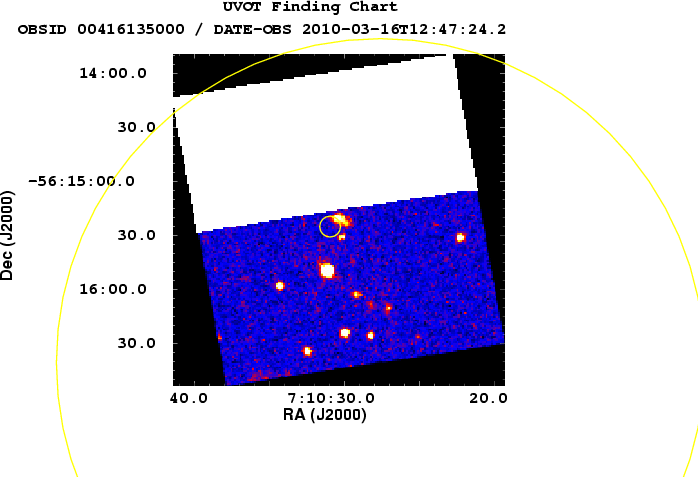
- GCN NOTICE
TITLE: GCN/SWIFT NOTICE
NOTICE_DATE: Tue 16 Mar 10 12:56:25 UT
NOTICE_TYPE: Swift-UVOT Source List
TRIGGER_NUM: 416135, Seg_Num: 0
POINT_RA: 107.643d {+07h 10m 34s} (J2000)
POINT_DEC: -56.271d {-56d 16' 16"} (J2000)
POINT_ROLL: 250.989d
IMG_START_DATE: 15271 TJD; 75 DOY; 10/03/16
IMG_START_TIME: 46196.78 SOD {12:49:56.78} UT, 306.4 [sec] since BAT Trigger Time
FILTER: 7, U
BKG_MEAN: 0.624
N_STARS: 150
X_OFFSET: 549 [pixels]
Y_OFFSET: 652 [pixels]
X_MAX: 1508 [pixels]
Y_MAX: 1611 [pixels]
DET_THRESH: 7
PHOTO_THRESH: 3
SL_URL: sw00416135000msufc0306.fits
SUN_POSTN: 356.17d {+23h 44m 41s} -1.66d {-01d 39' 28"}
SUN_DIST: 100.34 [deg] Sun_angle= -7.4 [hr] (East of Sun)
MOON_POSTN: 1.11d {+00h 04m 26s} +5.75d {+05d 44' 59"}
MOON_DIST: 103.94 [deg]
MOON_ILLUM: 0 [%]
GAL_COORDS: 266.92,-19.76 [deg] galactic lon,lat of the pointing direction
ECL_COORDS: 137.42,-76.79 [deg] ecliptic lon,lat of the pointing direction
COMMENTS: SWIFT-UVOT Source List.
- GCN NOTICE
TITLE: GCN/SWIFT NOTICE
NOTICE_DATE: Tue 16 Mar 10 12:56:25 UT
NOTICE_TYPE: Swift-UVOT Source List
TRIGGER_NUM: 416135, Seg_Num: 0
POINT_RA: 107.643d {+07h 10m 34s} (J2000)
POINT_DEC: -56.271d {-56d 16' 16"} (J2000)
POINT_ROLL: 250.989d
IMG_START_DATE: 15271 TJD; 75 DOY; 10/03/16
IMG_START_TIME: 46196.78 SOD {12:49:56.78} UT, 306.4 [sec] since BAT Trigger Time
FILTER: 7, U
BKG_MEAN: 0.624
N_STARS: 150
X_OFFSET: 549 [pixels]
Y_OFFSET: 652 [pixels]
X_MAX: 1508 [pixels]
Y_MAX: 1611 [pixels]
DET_THRESH: 7
PHOTO_THRESH: 3
SL_URL: sw00416135000msufc0306.fits
SUN_POSTN: 356.17d {+23h 44m 41s} -1.66d {-01d 39' 28"}
SUN_DIST: 100.34 [deg] Sun_angle= -7.4 [hr] (East of Sun)
MOON_POSTN: 1.11d {+00h 04m 26s} +5.75d {+05d 44' 59"}
MOON_DIST: 103.94 [deg]
MOON_ILLUM: 0 [%]
GAL_COORDS: 266.92,-19.76 [deg] galactic lon,lat of the pointing direction
ECL_COORDS: 137.42,-76.79 [deg] ecliptic lon,lat of the pointing direction
COMMENTS: SWIFT-UVOT Source List.
- GCN NOTICE
TITLE: GCN/SWIFT NOTICE
NOTICE_DATE: Tue 16 Mar 10 12:56:56 UT
NOTICE_TYPE: Swift-UVOT Processed Source List
TRIGGER_NUM: 416135, Seg_Num: 0
POINT_RA: 107.643d {+07h 10m 34s} (J2000)
POINT_DEC: -56.271d {-56d 16' 16"} (J2000)
POINT_ROLL: 250.989d
IMG_START_DATE: 15271 TJD; 75 DOY; 10/03/16
IMG_START_TIME: 46196.78 SOD {12:49:56.78} UT, 306.4 [sec] since BAT Trigger Time
FILTER: 7, U
BKG_MEAN: 0.624
N_STARS: 150
X_OFFSET: 549 [pixels]
Y_OFFSET: 652 [pixels]
X_MAX: 1508 [pixels]
Y_MAX: 1611 [pixels]
DET_THRESH: 7
PHOTO_THRESH: 3
SL_URL: sw00416135000msufc0306.fits
SUN_POSTN: 356.17d {+23h 44m 41s} -1.66d {-01d 39' 27"}
SUN_DIST: 100.34 [deg] Sun_angle= -7.4 [hr] (East of Sun)
MOON_POSTN: 1.11d {+00h 04m 27s} +5.75d {+05d 45' 06"}
MOON_DIST: 103.94 [deg]
MOON_ILLUM: 0 [%]
GAL_COORDS: 266.92,-19.76 [deg] galactic lon,lat of the pointing direction
ECL_COORDS: 137.42,-76.79 [deg] ecliptic lon,lat of the pointing direction
COMMENTS: SWIFT-UVOT Processed Source List.
COMMENTS: All 4 attachments are included.
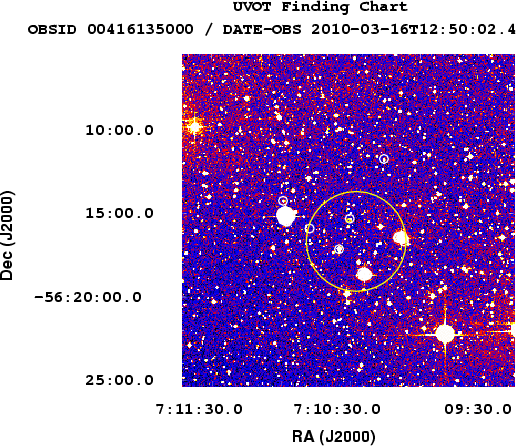
- GCN NOTICE
TITLE: GCN/SWIFT NOTICE
NOTICE_DATE: Tue 16 Mar 10 12:57:31 UT
NOTICE_TYPE: Swift-UVOT Image
TRIGGER_NUM: 416135, Seg_Num: 0
POINT_RA: 107.643d {+07h 10m 34s} (J2000)
POINT_DEC: -56.271d {-56d 16' 16"} (J2000)
ROLL: 250.989d
IMG_START_DATE: 15271 TJD; 75 DOY; 10/03/16
IMG_START_TIME: 46196.78 SOD {12:49:56.78} UT, 306.4 [sec] since BAT Trigger Time
FILTER: 7, U
EXPOSURE_ID: 290436602
X_OFFSET: 869 [pixels]
Y_OFFSET: 972 [pixels]
WIDTH: 160 [pixels]
HEIGHT: 160 [pixels]
X_GRB_POS: 1029
Y_GRB_POS: 1132
BINNING_INDEX: 1
IM_URL: sw00416135000msuni0312.fits
SUN_POSTN: 356.17d {+23h 44m 41s} -1.66d {-01d 39' 27"}
SUN_DIST: 100.34 [deg] Sun_angle= -7.4 [hr] (East of Sun)
MOON_POSTN: 1.12d {+00h 04m 28s} +5.75d {+05d 45' 13"}
MOON_DIST: 103.94 [deg]
MOON_ILLUM: 0 [%]
GAL_COORDS: 266.92,-19.76 [deg] galactic lon,lat of the pointing direction
ECL_COORDS: 137.42,-76.79 [deg] ecliptic lon,lat of the pointing direction
COMMENTS: SWIFT-UVOT Image.
COMMENTS: The GRB Position came from the XRT Position Command.
COMMENTS: The image has 2x2 binning (compression).
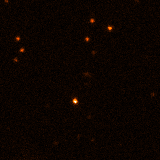
- GCN NOTICE
TITLE: GCN/SWIFT NOTICE
NOTICE_DATE: Tue 16 Mar 10 12:58:02 UT
NOTICE_TYPE: Swift-UVOT Processed Image
TRIGGER_NUM: 416135, Seg_Num: 0
POINT_RA: 107.643d {+07h 10m 34s} (J2000)
POINT_DEC: -56.271d {-56d 16' 16"} (J2000)
ROLL: 250.989d
IMG_START_DATE: 15271 TJD; 75 DOY; 10/03/16
IMG_START_TIME: 46196.78 SOD {12:49:56.78} UT, 306.4 [sec] since BAT Trigger Time
FILTER: 7, U
EXPOSURE_ID: 290436602
X_OFFSET: 869 [pixels]
Y_OFFSET: 972 [pixels]
WIDTH: 160 [pixels]
HEIGHT: 160 [pixels]
X_GRB_POS: 1029
Y_GRB_POS: 1132
BINNING_INDEX: 1
IM_URL: sw00416135000msuni0312.fits
SUN_POSTN: 356.17d {+23h 44m 41s} -1.66d {-01d 39' 26"}
SUN_DIST: 100.34 [deg] Sun_angle= -7.4 [hr] (East of Sun)
MOON_POSTN: 1.12d {+00h 04m 29s} +5.76d {+05d 45' 20"}
MOON_DIST: 103.94 [deg]
MOON_ILLUM: 0 [%]
GAL_COORDS: 266.92,-19.76 [deg] galactic lon,lat of the pointing direction
ECL_COORDS: 137.42,-76.79 [deg] ecliptic lon,lat of the pointing direction
COMMENTS: SWIFT-UVOT Processed Image.
COMMENTS: The GRB Position came from the XRT Position Command.
COMMENTS: The image has 2x2 binning (compression).
COMMENTS: All 4 attachments are included.
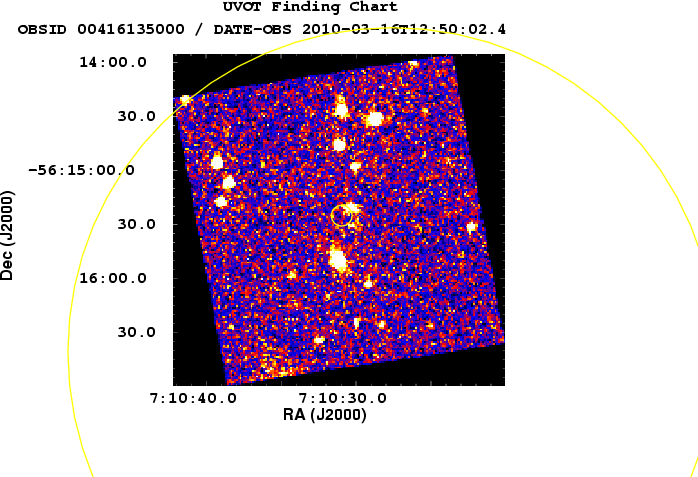
- GCN Circular #10496
M. Stamatikos (OSU/NASA/GSFC), S. D. Barthelmy (GSFC),
W. H. Baumgartner (GSFC/UMBC), A. P. Beardmore (U Leicester),
S. Campana (INAF-OAB), A. de Ugarte Postigo (INAF-OAB),
P. A. Evans (U Leicester), J. M. Gelbord (PSU),
C. Guidorzi (U Ferrara), S. T. Holland (CRESST/USRA/GSFC),
J. A. Kennea (PSU), H. A. Krimm (CRESST/GSFC/USRA),
R. Margutti (Univ Bicocca&OAB), F. E. Marshall (NASA/GSFC),
S. R. Oates (UCL-MSSL), C. Pagani (U Leicester),
K. L. Page (U Leicester), D. M. Palmer (LANL),
P. Romano (INAF-IASFPA), B. Sbarufatti (INAF-OAB/IASFPA),
R. L. C. Starling (U Leicester) and T. N. Ukwatta (GSFC/GWU) report on
behalf of the Swift Team:
At 12:44:50 UT, the Swift Burst Alert Telescope (BAT) triggered and
located GRB 100316D trigger=416135). Swift slewed immediately to the burst.
The BAT on-board calculated location is
RA, Dec 107.615, -56.278 which is
RA(J2000) = 07h 10m 28s
Dec(J2000) = -56d 16' 40"
with an uncertainty of 3 arcmin (radius, 90% containment, including
systematic uncertainty). This is an image trigger, but there is a
possibility that there is a low-level peak about 100 sec long.
The XRT began observing the field at 12:47:08.1 UT, 137.7 seconds after
the BAT trigger. XRT found a bright, uncatalogued X-ray source located
at RA, Dec 107.6291, -56.2567 which is equivalent to:
RA(J2000) = 07h 10m 30.98s
Dec(J2000) = -56d 15' 24.1"
with an uncertainty of 5.0 arcseconds (radius, 90% containment). This
location is 81 arcseconds from the BAT onboard position, within the BAT
error circle. No event data are yet available to determine the column
density using X-ray spectroscopy.
The initial flux in the 2.5 s image was 2.38e-09 erg cm-2 s-1 (0.2-10
keV).
UVOT took a finding chart exposure of 150 seconds with the White filter
starting 148 seconds after the BAT trigger. No credible afterglow candidate has
been found in the initial data products. Because part of the 2.7'x2.7'
sub-image was not received, the overlap with the XRT error circle is uncertain.
The coverage of the XRT error circle by the 8'x8' region for the list of
sources generated on-board is uncertain because the large number of sources
filled the available telemetry. No correction has been made for the expected
extinction corresponding to E(B-V) of 0.12.
Burst Advocate for this burst is M. Stamatikos (Michael.Stamatikos-1 AT nasa.gov).
Please contact the BA by email if you require additional information
regarding Swift followup of this burst. In extremely urgent cases, after
trying the Burst Advocate, you can contact the Swift PI by phone (see
Swift TOO web site for information: http://www.swift.psu.edu/too.html.)
- GCN Circular #10505
R.L.C. Starling, P.A. Evans (U. Leicester) and M. Stamatikos (OSU/NASA/GSFC)
report on behalf of the Swift-XRT team:
We have analysed the first orbit of Swift XRT data for GRB 100316D (Stamatikos
et al. GCN Circ. 10496), comprising 593 s of exposure
from 143 s to 737 s after the BAT trigger. The data are solely in
Windowed Timing (WT) mode. The light curve over this time decays very
slowly and can be modelled with a power-law with a decay index of
alpha=0.13+/-0.03.
A spectrum formed from these data can be fitted with an absorbed power-law with
a photon spectral index of 1.42 (+/-0.04). The best-fitting absorption column
is 5.9 (+/-0.3) x 10^21 cm^-2, in excess of the Galactic value of 7.0 x 10^20
cm^-2 (Kalberla et al. 2005). The counts to observed (unabsorbed) 0.3-10
keV flux conversion factor deduced from this spectrum is 6.6 x 10^-11
(8.7 x 10^-11) erg cm^-2 count^-1.
If the decay contines with alpha=0.13, the predicted count rate at T+24h
is 16 count s^-1 or an observed (unabsorbed) 0.3-10 keV flux of 1.1 (1.4)
x10^-9 erg cm-2 s-1.
The results of the XRT-team automatic analysis are available at
http://www.swift.ac.uk/xrt_products/00416135.
This circular is an official product of the Swift-XRT team.
- GCN Circular #10511
T. Sakamoto (GSFC/UMBC), S. D. Barthelmy (GSFC), W. H. Baumgartner (GSFC/UMBC),
J. R. Cummings (GSFC/UMBC), N. Gehrels (GSFC), H. A. Krimm (GSFC/USRA),
C. B. Markwardt (GSFC/UMD), D. M. Palmer (LANL), M. Stamatikos (GSFC/ORAU),
J. Tueller (GSFC), T. N. Ukwatta (GWU)
(i.e. the Swift-BAT team):
Using the data set from T-60 to T+243 sec from the telemetry downlinks,
we report further analysis of BAT GRB 100316D (trigger #416135)
(Stamatikos, et al., GCN Circ. 10496). The BAT ground-calculated position is
RA, Dec = 107.599, -56.275 deg, which is
RA(J2000) = 07h 10m 23.8s
Dec(J2000) = -56d 16' 28.9"
with an uncertainty of 3.0 arcmin, (radius, sys+stat, 90% containment).
The partial coding was 85%.
The mask-weighted light curve is relatively flat. The emission started
before T-80 sec when the location came into the BAT FoV during a
Swift planned-target slew. Using the event-by-event data, the lightcurve
conitinue through the 64-sec integration of the image trigger and out to
at least T+240 sec. Using the on-board mask-weighted lightcurve,
the lightcurve continues out to at least T+740 sec where the data ends.
The time-averaged spectrum using just the T+0.0 to T+64.0 sec image-trigger
interval is best fit by a simple power-law model. The power law index of the
time-averaged spectrum is 2.29 +- 0.41. The fluence in the 15-150 keV band
is 3.0 +- 0.8 x 10^-7 erg/cm2. The 1-sec peak photon flux measured
from T+0.00 sec in the 15-150 keV band is 0.1 +- 0.0 ph/cm2/sec.
All the quoted errors are at the 90% confidence level.
The results of the batgrbproduct analysis are available at
http://gcn.gsfc.nasa.gov/notices_s/416135/BA/
We note that this lightcurve is very non-typical for a GRB and that
the spectrum is soft. This is similar both in the temporal and spectral
properties to the GRB060218-SN2006aj burst (Camapana, et al.; Nature,
v224, p1008, Figure 1). In the 060218 burst, the BAT lightcurve was flat
from T-50 to T+300 sec. The X-ray temporal decay (Starling, GCN Circ 10505)
is shallow as it was in SN2006aj (Campana, Fig 1). We further note
that the 5 arcsec XRT error circle (GCN 10496) covers the edge
of an extended object (a pair of unresolved stars or a galaxy) in DSS.
- GCN Circular #10512
S.D. Vergani (GEPI-Obs. Paris), P. D'Avanzo (INAF-OAB), A.J. Levan (Univ.
Warwick), S. Covino (INAF-OAB), D. Malesani, J. Hjorth (DARK/NBI), L.A.
Antonelli (INAF-OAR) report on behalf of a larger collaboration:
We observed the field of GRB 100316D (Stamatikos et al., GCN 10496) with
the VLT equipped with the X-shooter spectrograph. Observations started on
2010 Mar 17 at 00:58 UT (~ 12 hours after the GRB). In the 100s
acquisition image, we detect an object inside the XRT error circle, at the
following position (J2000):
RA: 07:10:30.77
Dec: -56:15:20.7
(+/- 0.5"). The object has a magnitude R~21 (calibrated against USNO-B1.0)
and is very close (~3.5") to the DSS galaxy reported by Sakamoto et al.
(GCN 10511). In the X-shooter spectrum of this source we detect several
bright emission lines. Among these we have [OII], Hdelta, Hgamma, Hbeta,
[OIII], Halpha all at a common redshift of 0.059. At present, we cannot
say if this object (that might be a region of the nearby galaxy) is
related with GRB 100316D. Further analysis and observations are in
progress.
We caution that the above analysis (particularly the wavelength solution)
is preliminary. Reduction with updated calibrations is underway. We would
like to thank the ESO staff for their kind assistance, in particular
Thomas Rivinius, Alvaro Alvarez and Andres Pino
- GCN Circular #10513
S.D. Vergani (GEPI-Obs. Paris), A.J. Levan (Univ. Warwick), P. D'Avanzo
(INAF-OAB), S. Covino (INAF-OAB), D. Malesani, J. Hjorth (DARK/NBI), N.R.
Tanvir (Univ. Leicester), L.A. Antonelli (INAF-OAR) report on behalf of a
larger collaboration:
We carried out further observations of the field of GRB 100316D
(Stamatikos et al., GCN 10496) with the Gemini telescope equipped with
GMOS in imaging mode (~ 12 hours after the GRB). Inside the XRT error
circle we detect two discrete, compact objects, both of which lie on the
stellar field of the DSS galaxy (Sakamoto et al. GCN 10511; Vergani et al.
GCN 10512):
Object A:
RA (J2000): 07:10:30.77
Dec (J2000): -56:15:20.7
Object B:
RA (J2000): 07:10:30.48
Dec (J2000): -56:15:22.3
Both position have errors of approximately 0.5" in each axis. We note that
object "A" is the same reported by Vergani et al. (GCN 10512). We obtained
a VLT/X-shooter spectrum of source "B", which exhibits the same emission
lines reported by Vergani et al. (GCN 10512) for object "A" at the same
redshift of z=0.059. Likely, object "A" and "B" are regions of the nearby
DSS galaxy.
A finding chart is available at the following web page:
http://www.astro.ku.dk/~malesani/GRB/100316D/GRB100316D_finder.png
We caution that the above analysis (particularly the wavelength solution)
is preliminary. Reduction with updated calibrations is underway. We would
like to thank the Gemini staff for their kind assistance, in particular
Rodrigo Carrasco.
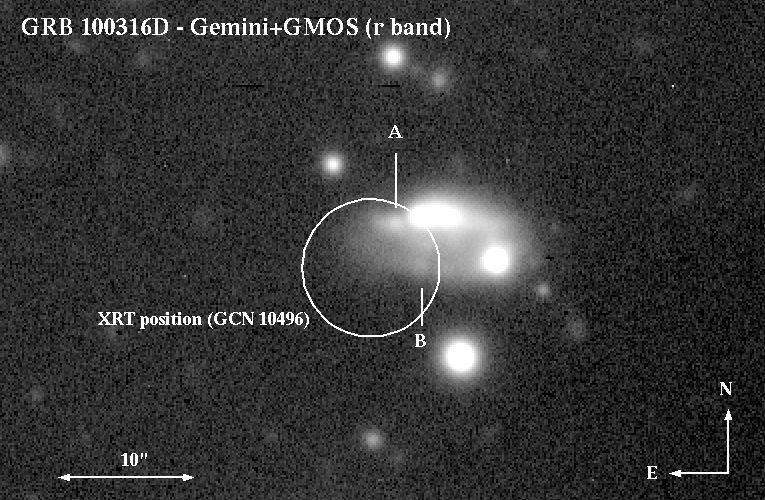
- GCN Circular #10514
Paulo Afonso (MPE Garching), Adria Updike (Clemson University), Marco
Nardini, Robert Filgas, Abdullah Yoldas, and Jochen Greiner (MPE Garching)
report on behalf of the GROND team:
We observed the field of GRB 100316D (Swift trigger 416135; Stamatikos et
al., GCN 10496) simultaneously in g'r'i'z'JHK with GROND (Greiner et al.
2008, PASP 120, 405) mounted at the 2.2 m ESO/MPI telescope at La Silla
Observatory (Chile).
Observations started at 00:28 UT on March 17, 11.66 hours after the GRB
trigger, and are continuing. They were performed at an average seeing of
1" and at an average airmass of 1.1.
We detect what appears to be a bright point on the edge of the extended
object noted by Sakamoto et al. (GCN 10511) within the XRT error circle.
This is consistent with the source identified by Vergani et al. (GCN
10512). The source is detected in all bands, suggesting a redshift < 3.5.
We cannot yet determine if this source is related to the GRB.
Further observations are required to establish variability, and to check
whether the optical bands show similarities to GRB 060218 - SN 2006aj as
reported by Sakamoto et al. (GCN 10511) for the gamma ray and x-ray bands.
- GCN Circular #10517
S. Campana (INAF-OAB) reports on behalf of the Swift-XRT team:
Swift XRT observed GRB 100316D (Stamatikos et al. 2010, GCN10496)
in Windowed Timing (WT) mode in the 144-737 s time interval.
During this interval the light curve decays very slowly (decay
index alpha=-0.13, Starling et al. 2010, GCN 10505).
In addition, the 1.5-10 keV to 0.3-1.5 keV hardness ratio remains
constant (reduced chi2=0.91 with 97 degrees of freedom, dof).
Motivated by the high count rate (around 30 c s^-1, but far from
the pile up limit) and by the constant spectral shape we tried to
estimate the GRB redshift from the X-ray data.
We assume a Galactic column density of 7x10^20 cm^-2 (Kalberla et
al. 2005, A&A 440 775) and fit the WT spectrum taken from the
Leicester pages (http://www.swift.ac.uk/xrt_spectra/00416135/)
with an absorbed (phabs*zphabs) cutoff power law model (the cutoff
power law model provides much better results in terms of column
density evaluation with respect to a simple power law model when
small spectral variations are present). Given the high count rate
we selected single pixel events only.
The resulting fit is good (reduced chi2=1.2, 333 dof). The redshift
is constrained to lie within the 90% confidence level (delta
chi2=2.71) of 0.014
The contour plot is available at
http://www.brera.inaf.it/utenti/campana/100316d.gif
This circular is an official product of the Swift-XRT team.
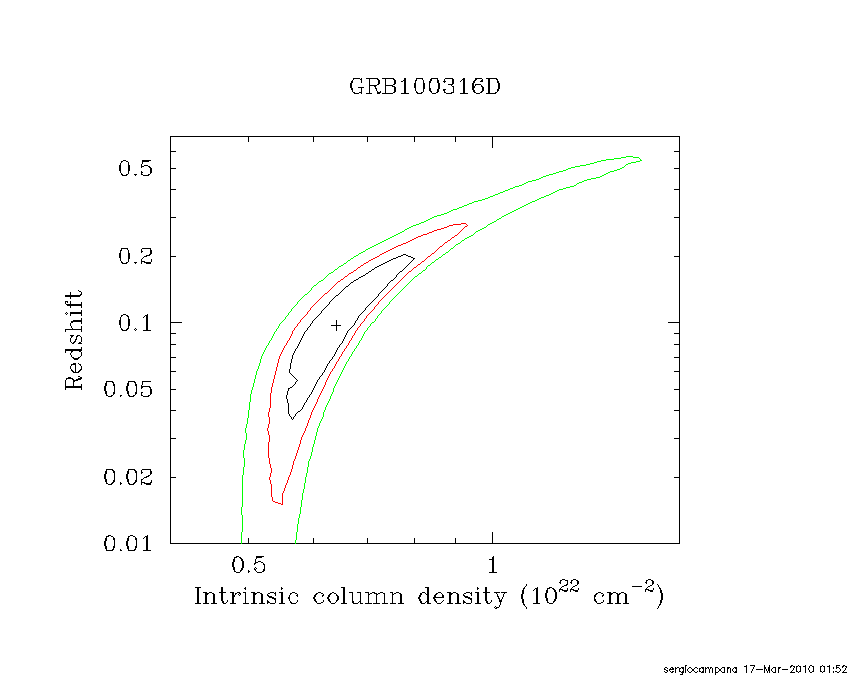
- GCN Circular #10519
R.L.C. Starling, P.A. Evans (U. Leicester) and M. Stamatikos
(OSU/NASA/GSFC) report on behalf of the Swift XRT team:
We have now analysed the first 3 orbits of Swift XRT data for GRB 100316D
(trigger=416135, Stamatikos et al. GCN Circ. 10496),
comprising 8 s of Windowed Timing (WT) settling mode data, 593 s of WT
mode data and 3.7 ks of Photon Counting (PC) mode data. The early light
curve is flat and can be modelled with a power-law decay with a decay
index of alpha=0.13+/-0.03 as described in Starling et al. (GCN Circ.
10505). This now breaks at some time after T+750 s to a steeper decay of
alpha=2.0 +0.3/-0.1.
Using 1967 s of XRT Photon Counting mode data and 1 U-band UVOT
image, we find an astrometrically corrected X-ray position (using the
XRT-UVOT alignment and matching UVOT field sources to the USNO-B1
catalogue): RA, Dec = 107.62763, -56.25547 which is equivalent to:
RA (J2000): 07h 10m 30.63s
Dec (J2000): -56d 15' 19.7"
with an uncertainty of 3.7 arcsec (radius, 90% confidence).
This position may be improved as more data are received. The latest
position can be viewed at http://www.swift.ac.uk/xrt_positions. Position
enhancement is described by Goad et al. (2007, A&A, 476, 1401) and Evans
et al. (2009, MNRAS, 397, 1177).
We note that this position is 1.5 arcsec from the optical/nIR candidate
'Object A' reported in the VLT/X-Shooter and Gemini/GMOS observations by
Vergani et al. (GCN Circ. 10513) and GROND observations reported by Afonso
et al. (GCN Circ. 10514), and 2.9 arcsec from the candidate 'Object B'
reported in GCN Circ. 10513.
This circular is an official product of the Swift-XRT team.
- GCN Circular #10520
S. R. Oates (MSSL-UCL), M. De Pasquale (MSSL-UCL) and M. Stamatikos
(OSU/NASA/GSFC)
report on behalf of the Swift/UVOT team:
The Swift/UVOT began settled observations of the field of
GRB 100316D 148s after the BAT trigger (Stamatikos et al., GCN Circ.
10496).
Coincident with the refined Swift XRT error circle (Starling et al.
GCN Circ. 10519),
we detect the DSS galaxy, which hosts the sources A and B
(Vergani et al. GCN Circ. 10512, 10513), but we are unable to
resolve it. Our photometry, performed on 3ks of data
in the 7 UVOT filters, shows no change larger than 1 sigma in
the flux of this DSS galaxy.
- GCN Circular #10523
A.J. Levan (U. Warwick), N.R. Tanvir (U. Leicester), P. D'Avanzo
(INAF-OAB), S.D. Vergani (GEPI-Obs. Paris), D. Malesani (DARK/NBI)
report for a larger collaboration.
"We re-observed the location of GRB 100316D (Stamatikos et al. GCN
10496; Starling et al. GCN 10519) using Gemini/GMOS in the r-band.
Observations began at 23:55 UT, approximately 36 hours after the
GRB, and 24 hours after our first epoch (Vergani et al. GCN 10513).
The seeing in the second epoch is slightly worse than the first
(0.9" versus 0.7") and so the resulting images are slightly shallower.
No obvious objects within the refined XRT error circle (Starling
et al. GCN 10519) show significant (>3 sigma) evidence for variation.
However, we do note the presence of a previously unreported
compact source that is within the X-ray error circle, but is close
to the nucleus of the galaxy, at
RA(J2000) = 07:10:30.54
Dec(J2000) = -56:15:20.0
This source is brighter than those previously discussed in GCN 10513
(R~20) but again, given the difficulty of performing accurate photometry
against a bright and varying background of the host, we can't as yet
make any firm statements about variability.
We note, it is of course possible that a brightening supernova
component and fading afterglow are conspiring to mask variability
between these two epochs, and further observations are planned.
We thank the staff of Gemini, in particular Rodrigo Carrasco for
their help in executing these observations."
- GCN Circular #10524
T. Sakamoto (GSFC/UMBC), S. D. Barthelmy (GSFC), W. H. Baumgartner (GSFC/UMBC),
J. R. Cummings (GSFC/UMBC), N. Gehrels (GSFC), C. B. Markwardt (GSFC/UMD),
D. M. Palmer (LANL), M. Stamatikos (GSFC/OSU)
(i.e. the Swift-BAT team):
Using the BAT hard X-ray survey data (Detector Plane Histogram data), we have
processed the BAT survey data for pre- and post-trigger periods using the batsurvey
script and have extracted the flux at the location of the GRB. While Swift was pointing at
GRB 100316C from T-2650 s to T-80 s, the GRB 100316D location was in the FOV of BAT.
At 12:43, Swift slewed to a pre-planned target (1E 1048.1-5937), and triggered on GRB 100316D.
After re-pointing to the location of GRB 100316D, Swift slewed away from GRB 100316D
at T+750 s due to an observational constraint. GRB 100316D came back into the FOV of BAT
at T+5050 s (a pre-planned observation of 1E 1048.1-5937).
The BAT light curve in the 14-195 keV band around the trigger time is available at:
-Light curve from T-6000 sec to T+6000 sec:
http://gcn.gsfc.nasa.gov/other/GRB100316D_bat_lc.gif
-Zoom-in light curve from T-2000 sec to T+1000 sec:
http://gcn.gsfc.nasa.gov/other/GRB100316D_bat_lc_zoomin.gif
The light curve produced by the BAT event-by-event data is overlaid with the survey light
curve in the figure. There is a probable early low-level emission starting from T-1500 s.
The emission then rises at T-500 s, peaks at T-100 s, and decays with an exponential
decay constant of ~750 s. The emission continues through the slew at T+750 s.
The emission is no longer detected by BAT after T+5050 s.
As pointed out in Sakamoto et al. (GCN Circ. 10511), the BAT light curve profile of
GRB 100316D is very similar to the GRB 060218-SN2006aj burst
(Camapana, et al.; Nature, v224, p1008). The BAT light curve of GRB 060218 shows
a rise at T-300 s, a peak at T+450 s, and an exponential decay constant of ~500 s,
with a duration of ~2000 sec. GRB 100316D was detected in Swift-BAT from ~T-500 sec
to at least ~T+800 sec, hence the lower limit on the duration of GRB 100316D is ~1300 sec.
The fluence in the 15-150 keV band measured with the available 955 seconds of event data
is 3.4 x 10^-6 erg/cm2. This corresponds to an isotropic equivalent
energy (Eiso) of 3.1x10^49 ergs in the 15.88 keV - 158.85 keV band at the GRB rest frame
assuming a redshift z=0.059 of a potential source and a galaxy inside the XRT error
circle (Vergani et al. GCN Circ. 10512, 10513). This unusually long duration in
concert with a soft spectrum and a low Eiso (Eiso of GRB 060218 was
6.2x10^49 ergs) strengthens the similarity between GRBs 100316D and 060218. Although
the lack of a clear optical counterpart to GRB 100316D at this stage is distinctly
different than GRB 060218, the prompt emission characteristics are very much like
supernova-associated GRB 060218. Hence, we suggest additional follow-up observations
especially in the IR that may confirm the presence of a host supernova.
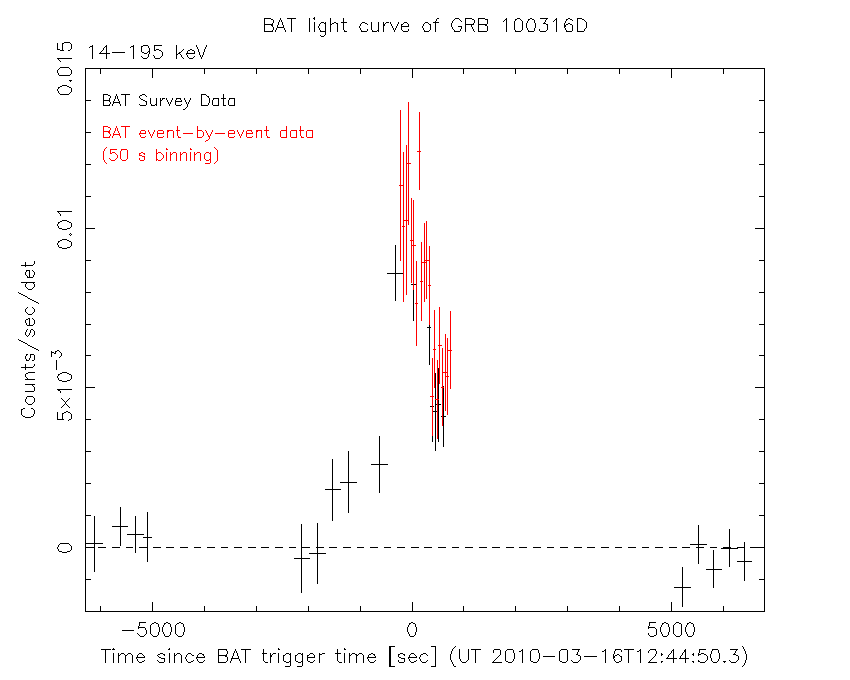
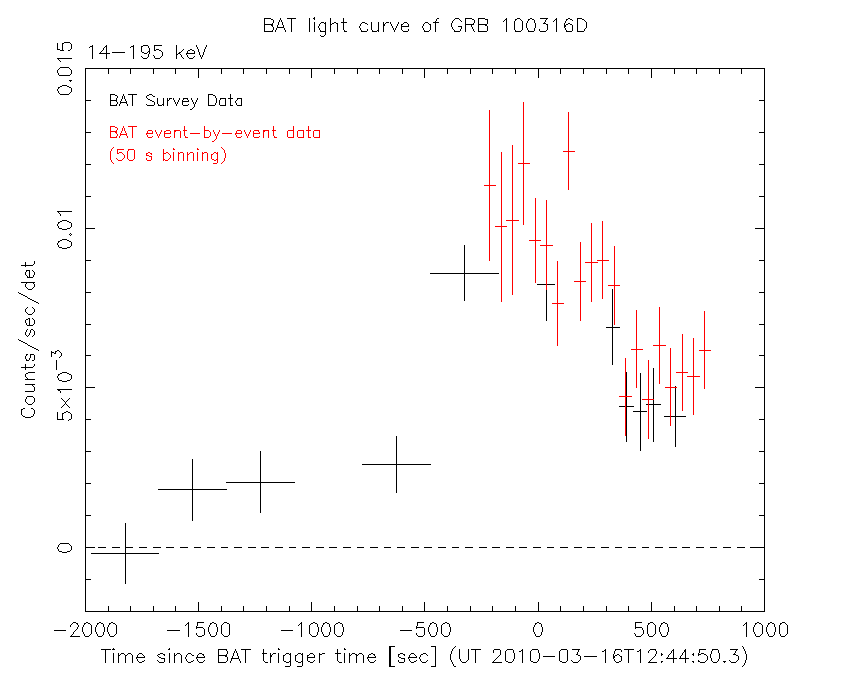
- GCN Circular #10525
K. Wiersema (U. Leicester), P. D'Avanzo (INAF-OAB), A.J. Levan (U.
Warwick), N.R. Tanvir (U. Leicester), D. Malesani (DARK/NBI), S.
Covino (INAF-OAB) report for a larger collaboration:
"We obtained a third epoch of observations of the localization of
GRB 100316D (Stamatikos et al. GCN 10496; Starling et al. GCN
10519) using Gemini South and GMOS. Observations began at 23:48 UT
on March 18, and were obtained in the r-band under excellent
seeing (0.5"). Image subtraction reveals that the source previously
identified by Levan et al (GCN 10523), has brightened between the two
observations by ~0.3 magnitudes. We suggest that this object
represents the rising supernova associated with GRB 100316D.
Images of the field, and the subtraction can be found at
http://www.star.le.ac.uk/~anl/100316D
Further observations are planned.
We thank the staff of Gemini for their help in executing these
observations"
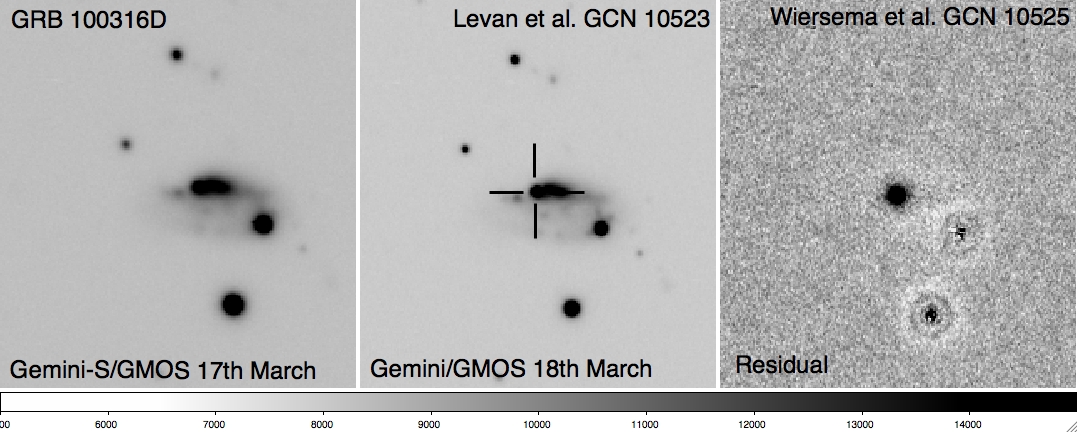
- GCN Circular #10533
Mark Wieringa (CSIRO), Alicia Soderberg (Harvard/CfA), and Phil Edwards
(CSIRO) report:
"We observed the field of GRB 100316D (Stamatikos et al. GCN 10496) with
the Australia Telescope Compact Array beginning on Mar 18.35 for 3.5 hrs.
Data were collected at central frequencies of 5.4 and 9.0 GHz with 2 GHz
bandwidth each. We do not detect any radio sources within the refined
XRT error circle (Starling et al. GCN 10519). We place upper
limits of 104 microJy at 5.4 GHz and 165 microJy at 9.0 GHz (4 sigma).
At the redshift of the host galaxy (z=0.059; Vergani et al. GCN 10512),
these limits imply a radio spectral luminosity below 8e+27 erg/s/Hz
which is a factor of 2 to 10 lower than the radio afterglow luminosities
observed for nearby long-duration GRBs 980425 (Kulkarni et al. 1998),
031203 (Soderberg et al. 2004), and 060218 (Soderberg et al. 2006) on
comparable timescales. Further observations are planned."
- GCN Circular #10541
R. Chornock, A. M. Soderberg, R. J. Foley, E. Berger, A. Frebel, P. Challis
(Harvard/CfA), J. D. Simon, and S. Sheppard (Carnegie) report:
We have been obtaining nightly spectra of GRB 100316D (Stamatikos et al., GCN
10496) with the MagE, LDSS3, and IMACS spectrographs on the twin 6.5-m Magellan
telescopes, starting on 2010 March 18.0 UT, approximately 1.5 days after the BAT
trigger. All spectra included the variable point source found by Levan et al.
(GCN 10523) and Wiersema et al. (GCN 10525) within the slit aperture.
All spectra show superposed high-equivalent-width nebular emission lines at
z=0.059, in agreement with Vergani et al. (GCN 10512). Our earliest spectra
show a very blue continuum with a few weak stellar features indicative of some
starlight from a young stellar population falling within our spectroscopic
aperture, but no other obvious features. By the time of our most recent MagE
spectrum, from March 22.0 UT (T0+5.5 days), a few broad undulations in the
continuum have developed, although contamination from the galaxy light and
possibly an afterglow remains significant. The strongest feature has a flux
peak near 7850 Angs (in the rest frame) and a minimum near 7280 Angs. An
additional local minimum in the continuum is located near 5700 Angs with a broad
maximum located to the red of that. The appearance of undulations in the
spectrum near the expected locations of supernova features from a comparison
with SN 1998bw at early times (while no such undulations appear in our earliest
spectra) leads us to conclude that we have spectroscopically determined that the
transient source which was detected photometrically (Wiersema et al., GCN 10525)
is a supernova.
A plot of an early and a recent spectrum compared to SN 1998bw can be found here:
http://www.cfa.harvard.edu/~eberger/grb100316d-mage.pdf
- GCN Circular #10543
F. Bufano, S. Benetti, E. Cappellaro, INAF Osservatorio Astronomico di
Padova (INAF-OAPd); S. Covino, INAF Osservatorio Astronomico di Brera
(INAF-OABr); S. Vergani, P.Goldoni, GEPI (Observatoire de Paris) - APC
(Universit� Paris 7); M. Della Valle, INAF Osservatorio di
Capodimonte; E. Pian, INAF Osservatorio Astronomico di Trieste; S.
Campana, G.Tagliaferri, INAF-OABr; D.Malesani, J. Fynbo, Dark
Cosmology Centre; M. Turatto, INAF Osservatorio Astronomico di
Catania; F.Patat, European Southern Observatory (ESO) and P. Mazzali,
INAF-OAPd report that a high-dispersion optical spectrum (range
350-900 nm, resolution 0.02 nm) of the afterglow associated to GRB
100316D (cf. GCN 10496) was obtained with the VLT telescope
(+XShooter) at ESO-Paranal on March 23.04 UT. The spectrum of the
source located at R.A.=07:10:31.8 and Decl.=-56:15:20.2, J2000.0 (as
measured on the XShooter acquisition image) shows very broad bumps
with peaks measured at about 430nm and 670nm reminiscent of an
emerging broad line type Ic supernova. Indeed, above 600 nm the
spectrum of this source shows some similarities with that of SN 1998bw
(Patat et al. 2001, ApJ, 555, 900) taken 7 days after outburst.
There are however major differences with the spectrum of this
transient, showing a significant flux deficiency in the range
450-550nm in comparison with SN 1998bw .
- CBET #2227
SUPERNOVA 2010bh = GRB 100316D
F. Bufano, S. Benetti, and E. Cappellaro, Istituto Nazionale di
Astrofisica (INAF), Osservatorio Astronomico di Padova (OAP); S. Covino, INAF,
Osservatorio Astronomico di Brera (OAB); S. Vergani, Galaxie, Etoile,
Physique, Instrumentation (GEPI), Observatoire de Paris, and Astroparticule
et Cosmologie (APC), Universite Paris 7; P. Goldoni, APC, Universite Paris 7,
and Service d'Astrophysique, Commissariat a l'Energie Atomique (CEA); M.
Della Valle, INAF, Osservatorio di Capodimonte; E. Pian, INAF, Osservatorio
Astronomico di Trieste; S. Campana and G. Tagliaferri, INAF, OAB; D. Malesani
and J. Fynbo, Dark Cosmology Centre, University of Copenhagen; M. Turatto,
INAF, Osservatorio Astronomico di Catania; F. Patat, European Southern
Observatory (ESO); and P. Mazzali, INAF, OAP, on behalf of a larger
collaboration, report that a high-dispersion optical spectrum (range 350-900
nm, resolution 0.02 nm) of the afterglow associated with GRB 100316D (cf.
GCN 10496; visible at http://gcn.gsfc.nasa.gov/gcn3/10496.gcn3) was obtained
with the Very Large Telescope (+ XShooter) at ESO/Paranal on Mar. 23.04 UT.
The spectrum of the source located at R.A. = 7h10m31s.8 and Decl. =
-56o15'20".2 (equinox 2000.0; as measured on the XShooter acquisition image)
shows very broad bumps with peaks measured at about 430 and 670 nm,
reminiscent of an emerging broadline type-Ic supernova (in agreement with
Chornock et al., GCN 10541). Indeed, above 600 nm, the spectrum of this
source shows some similarities with that of SN 1998bw (Patat et al. 2001,
Ap.J. 555, 900) taken seven days after outburst. There are, however, major
differences with the spectrum of this transient, showing a significant flux
deficiency in the range 450-550 nm, in comparison with SN 1998bw. The
designation 2010bh is assigned to this supernova.
- CBET #2228
SUPERNOVA 2010bh
R. Chornock, A. M. Soderberg, R. J. Foley, E. Berger, A. Frebel, and P.
Challis, Harvard-Smithsonian Center for Astrophysics; J. D. Simon and S.
Sheppard, Carnegie Observatories, report on the spectroscopic discovery of a
supernova associated with GRB 100316D (Stamatikos et al., GCN 10496; visible
at http://gcn.gsfc.nasa.gov/gcn3/10496.gcn3); the designation 2010bh was
announced on CBET 2227: "Nightly observations were obtained with the MagE,
LDSS3, and IMACS spectrographs on the twin 6.5-m Magellan telescopes,
starting on Mar. 18.0 UT, approximately 1.5 days after the Burst Alert
Telescope trigger. All spectra included the variable point source found by
Levan et al. (GCN 10523) and Wiersema et al. (GCN 10525) within the slit
aperture. Our spectra show superposed high-equivalent-width nebular
emission lines at z = 0.059, in agreement with Vergani et al. (GCN 10512).
Our earliest spectra show a very blue continuum with a few weak stellar
features, indicative of some starlight from a young stellar population
falling within our spectroscopic aperture, but no other obvious features. By
the time of our most recent MagE spectrum (range 350-1000 nm), from Mar. 22.0
UT (5.5 days after the GRB), a few broad undulations in the continuum have
developed, although contamination from the galaxy light, and possibly an
afterglow, remains significant. The strongest feature has a flux peak near
785 nm (in the rest frame) and a minimum near 728 nm. An additional local
minimum in the continuum is located near 570 nm, with a broad maximum located
to the red of that. The appearance of these undulations in the continuum is
broadly similar to those seen in peculiar broad-lined type-Ic supernovae such
as SN 1998bw."
- GCN Circular #10547
Arne Rau, Marco Nardini (both MPE Garching), Adria Updike (Clemson
University), Robert Filgas, Jochen Greiner, Thomas Kruehler (all MPE
Garching), and Sylvio Klose (TLS Tautenburg) report on behalf of the
GROND team:
We report on additional observations of the field of GRB 100316D
(Swift trigger 416135; Stamatikos et al., GCN 10496) simultaneously in
g'r'i'z'JHK with GROND (Greiner et al. 2008, PASP 120, 405) mounted at
the 2.2 m MPI/ESO telescope at La Silla Observatory (Chile).
Observations started on 17 March 2010 at 00:27 UT, 11.7 hours after
the burst (Afonso et al., GCN Circular #10514). The field was observed
during additional 16 epochs and observations are continuing.
Image subtraction revealed the supernova SN2010bh reported by Wiersema
et al. (GCN Circular #10525), Chornock et al. (GCN Circular #10541),
and Bufano et al. (GCN Circular #10543) to emerge approx. 5 days
post-burst and to reach an AB magnitude of r ~ 18.8 +/- 0.2 at 7.5
days post-burst.
The observed light curve evolution of SN2010bh is similar to that of
SN1998bw (Galama et al. 1998), the supernova associated with
GRB980425, shifted to the redshift of GRB100316D (z=0.059; Vergani et
al., GCN Circular #10512). The optical luminosity is comparable to
SN1998bw, except in the g-band, where the flux is suppressed by
approx. 30%. This likely corresponds to the significant flux
deficiency in the range 450-550nm reported from the X-Shooter spectrum
(Bufano et al., GCN Circular #10543).
- 1004.2262 from 15 Apr 10
Ryan Chornock et al.: Spectroscopic Discovery of the Broad-Lined Type Ic Supernova 2010bh Associated with the Low-Redshift GRB 100316D
Bochanski, Peter J. Challis, Robert P. Kirshner, Philipp Podsiadlowski, Katherine Roth, Robert E. Rutledge, Brian P. Schmidt, Scott S.
Sheppard, Robert A. Simcoe
Astrophysics (astro-ph.SR)
We present the spectroscopic discovery of a broad-lined Type Ic supernova (SN 2010bh) associated with the nearby long-duration gamma-ray burst
(GRB) 100316D. At z = 0.0593, this is the third-nearest GRB-SN. Nightly optical spectra obtained with the Magellan telescopes during the first
week after explosion reveal the gradual emergence of very broad spectral features superposed on a blue continuum. The supernova features are
typical of broad-lined SNe Ic and are generally consistent with previous supernovae associated with low-redshift GRBs. However, the inferred
velocities of SN 2010bh at 21 days after explosion are a factor of ~2 times larger than those of the prototypical SN 1998bw at similar epochs,
with v ~ 26,000 km/s, indicating a larger explosion energy or a different ejecta structure. A near-infrared spectrum taken 13.8 days after
explosion shows no strong evidence for He I at 1.083 microns, implying that the progenitor was largely stripped of its helium envelope. The
host galaxy is of low luminosity (M_R ~ -18.5 mag) and low metallicity (Z < 0.4 Z_solar), similar to the hosts of other low-redshift GRB-SNe.
- GCN Report 278.1
GCN_Report 278.1 has been posted:
http://gcn.gsfc.nasa.gov/reports/report_278_1.pdf
by M. Stamatikos
at OSU-CCAPP/GSFC
titled: "Final Swift Observations of GRB 100316D"
- 1104.2865 from 15 Apr 11
Emily M. Levesque et al.: Metallicity in the GRB 100316D/SN 2010bh Host Complex
The recent long-duration GRB 100316D, associated with supernova SN 2010bh, is one of the nearest GRB-SNe ever observed (z = 0.059). This
provides us with a unique opportunity to study the explosion environment on ~kpc scale in relation to the host galaxy complex. Here we present
spatially-resolved spectrophotometry of the host galaxy, focusing on both the explosion site and the brightest star-forming regions. Using
these data, we extract the spatial profiles of the relevant emission features (Halpha, Hbeta, [OIII] 5007A, and [NII] 6584A), and use these
profiles to examine variations in metallicity and star formation rate as a function of position in the host galaxy. We conclude that GRB
100316D/SN2010bh occurred in a low-metallicity host galaxy, and that the GRB-SN explosion site corresponds to the region with the lowest
metallicity and highest star formation rate sampled by our observations.
- 1104.3087 from 18 Apr 11
Rhaana L.C. Starling et al.: Discovery of a gamma-ray burst with an associated supernova
We report the discovery of the nearby long, soft GRB 100316D, and the subsequent unveiling of its host galaxy and associated supernova. We
study the extremely unusual prompt emission with time-resolved gamma-ray to X-ray spectroscopy and find that a thermal component in addition to
the synchrotron spectrum is required. The host galaxy is a bright, blue galaxy with a highly disturbed morphology. From optical photometry and
spectroscopy we provide an accurate astrometry and redshift, and derive the key host properties of star formation rate and stellar age. We
compare our findings for this GRB-SN with the well known previous case of GRB 060218. GRB 100316D is an important addition to the current
sparse sample of spectroscopically confirmed GRB-SNe, from which a better understanding of long GRB progenitors and the GRB-SN connection can
be gleaned.
- 1111.4527 from 22 Nov 11
Filomena Bufano et al.: The Fast and Faint SN 2010bh Associated with GRB 100316D
Daniele Malesani, Enrico Cappellaro, Massimo Della Valle, Johan Fynbo, Jens Hjorth, Paolo A. Mazzali, Daniel E. Reichart, Rhaana L. C.
Starling, Massimo Turatto, Susanna D. Vergani, Klass Wiersema, Lorenzo Amati, David Bersier, Sergio Campana, Zach Cano, Alberto J.
Castro-Tirado, Guido Chincarini, Valerio D'Elia, Antonio de Ugarte Postigo, Jinsong Deng, Patrizia Ferrero, Alexei V. Filippenko, Paolo
Goldoni, Javier Gorosabel, Jochen Greiner, Francois Hammer, Pall Jakobsson, Lex Kaper, Koji S. Kawabata, Sylvio Klose, Andrew J. Levan, Keiichi
Maeda, Nicola Masetti, Bo Milvang-Jensen, Felix I. Mirabel, Palle Moller, Kenichi Nomoto, Eliana Palazzi, Silvia Piranomonte, et al. (5
We present the spectroscopic and photometric evolution of the nearby (redshift 0.059) spectroscopically confirmed Type Ic supernova, SN 2010bh,
associated with a soft, long-duration gamma-ray burst (X-ray flash) GRB 100316D. Intensive follow-up observations of SN 2010bh were performed
at the ESO Very Large Telescope (VLT), using the X-shooter and FORS2 instruments. Owing to the detailed temporal coverage and the extended
wavelength range (300-2500 nm), we obtained an unprecedentedly rich spectral sequence among the hypernovae, making SN 2010bh one of the best
studied representatives of this SN class. We find that SN 2010bh has a more rapid rise to maximum brightness (8.0+/-1.0 days) and a fainter
absolute peak luminosity (L(bol)~3e42 ergs) than previously observed SN events associated with GRBs. Our estimate of the ejected (56)Ni mass is
0.12+/-0.02 Msun. From the broad spectral features we measure large expansion velocities, higher than those of SNe 1998bw (GRB 980425) and
2006aj (GRB 060218). The light-curve shape and photospheric expansion velocities of SN 2010bh suggest that we witnessed a relatively
high-energy explosion with a small ejected mass (E(k)~1e52 erg and M(ej)~3 Msun). The observed properties of SN 2010bh further extend the
heterogeneity of the class of GRB supernovae.
- 1208.0307 from 2 Aug 12
Zach Cano: The Nature of Gamma Ray Burst Supernovae
Gamma Ray Bursts (GRBs) and Supernovae (SNe) are among the brightest and most energetic physical processes in the universe. It is known that
core-collapse SNe arise from the gravitational collapse and subsequent explosion of massive stars (the progen- itors of nearby core-collapse
SNe have been imaged and unambiguously identified). It is also believed that the progenitors of long-duration GRBs (L-GRBs) are massive stars,
mainly due to the occurrence and detection of very energetic core-collapse su- pernovae that happen both temporally and spatially coincident
with most L-GRBs. However many outstanding questions regarding the nature of these events exist: How massive are the progenitors? What
evolutionary stage are they at when they explode? Do they exist as single stars or in binary systems (or both, and to what fractions)?
The work presented in this thesis attempts to further our understanding at the types of progenitors that give rise to long-duration GRB
supernovae (GRB-SNe). This work is based on optical photometry obtained for three GRB-SNe events: GRB 060729, GRB 090618 and XRF 100316D (an
X-Ray Flash is similar to a L-GRB, but has a lower peak energy). For GRB 060729 and GRB 090618 we model the optical light curves and account
for light coming from three sources: the host galaxy, the afterglow and the supernova. When we remove the host flux, and model the afterglow,
the re- maining flux resembles that of a SN, both in the shape of the light curve and the shape of the spectral energy distribution.
Our investigation of XRF 100316D and its spectroscopically-confirmed Ic-BL SN 2010bh is more detailed as we were able to obtain optical and
infrared data in many filters, which we utilize to created a quasi-bolometric light curve that we model to determine physical parameters of the SN...
- 1308.1687 from 9 Aug 13
R. Margutti et al.: The signature of the central engine in the weakest relativistic explosions: GRB100316D
We present late-time radio and X-ray observations of the nearby sub-energetic Gamma-Ray Burst (GRB)100316D associated with supernova (SN)
2010bh. Our broad-band analysis constrains the explosion properties of GRB100316D to be intermediate between highly relativistic, collimated
GRBs and the spherical, ordinary hydrogen-stripped SNe. We find that ~10^49 erg is coupled to mildly-relativistic (Gamma=1.5-2),
quasi-spherical ejecta, expanding into a medium previously shaped by the progenitor mass-loss with rate Mdot ~10^-5 Msun yr^-1 (for wind
velocity v_w = 1000 km s^-1). The kinetic energy profile of the ejecta argues for the presence of a central engine and identifies GRB100316D as
one of the weakest central-engine driven explosions detected to date. Emission from the central engine is responsible for an excess of soft
X-ray radiation which dominates over the standard afterglow at late times (t>10 days). We connect this phenomenology with the birth of the most
rapidly rotating magnetars. Alternatively, accretion onto a newly formed black hole might explain the excess of radiation. However, significant
departure from the standard fall-back scenario is required.
- 1606.01956 from 8 Jun 16
Amy Lien et al.: The Third Swift Burst Alert Telescope Gamma-Ray Burst Catalog
To date, the Burst Alert Telescope (BAT) onboard Swift has detected ~ 1000 gamma-ray bursts (GRBs), of which ~ 360 GRBs have redshift
measurements, ranging from z = 0.03 to z = 9.38. We present the analyses of the BAT-detected GRBs for the past ~ 11 years up through
GRB151027B. We report summaries of both the temporal and spectral analyses of the GRB characteristics using event data (i.e., data for each
photon within approximately 250 s before and 950 s after the BAT trigger time), and discuss the instrumental sensitivity and selection effects
of GRB detections. We also explore the GRB properties with redshift when possible. The result summaries and data products are available at this
http URL In addition, we perform searches for GRB emissions before or after the event data using the BAT survey data. We estimate the false
detection rate to be only one false detection in this sample. There are 15 ultra-long GRBs (~ 2% of the BAT GRBs) in this search with confirmed
emission beyond ~ 1000 s of event data, and only two GRBs (GRB100316D and GRB101024A) with detections in the survey data prior to the starting
of event data.
![]() Previous IAU Circulars
Previous IAU Circulars 













